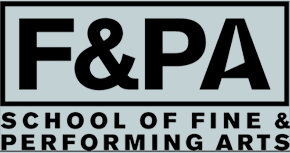Lewis Hine, Child Labor Investigator
Curated by Anna Conlan and Amy Fredrickson
February 6 – July 11, 2021
Sara Bedrick Gallery
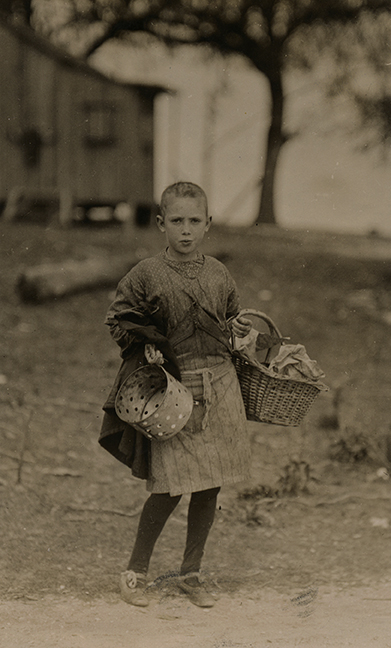
Lewis Hine, Sadie Kelly, 11 years old, Picks shrimp for the Peerless Oyster Co. Picked 7 pots yesterday, 5 pots today at 5 cents. Picked last year., 1911, Samuel Dorsky Museum of Art, gift of Howard Greenberg
• See the Curator Talk with Amy Fredrickson on Lewis Hine, Child Labor Investigator
In 1908, Lewis Hine (1874–1940) quit his job as a New York City school teacher and embarked on a mission for the National Child Labor Committee to photograph young children working in unsafe conditions. For the next sixteen years, Hine traveled throughout the United States documenting the harsh lives of children—sometimes as young as four years old—who were working long days in factories, mills, farms, and coal mines. At this time there were no federal laws against child labor, and state regulations were routinely broken.
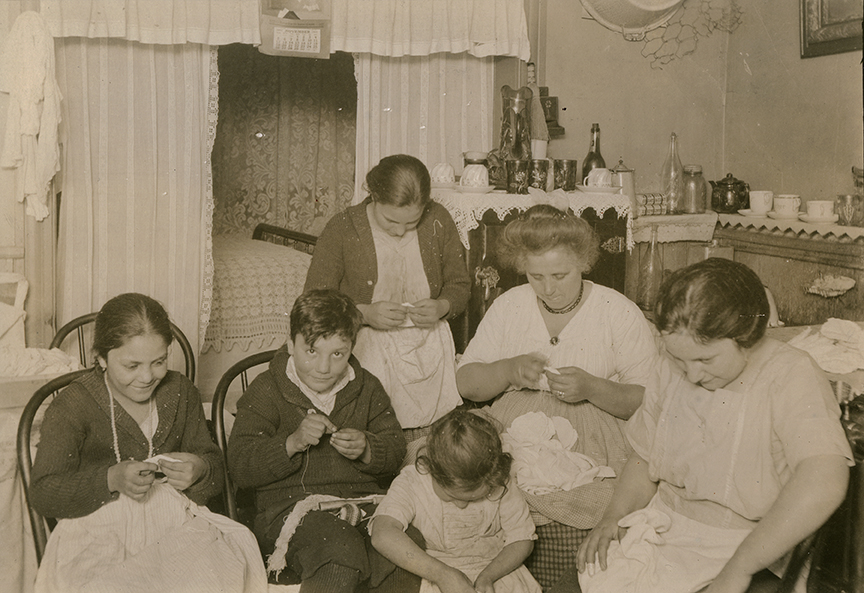
Lewis Hine, Powder puffs, 45 cents per gross. Family attempting to finish 9 gross in less than a week. Boy's hands were very dirty. Location: New Jersey., 1922, Samuel Dorsky Museum of Art, gift of Howard Greenberg
Hine understood the power of his photographs and their potential impact, and so did factory foremen. After his early photographs were published, implicated business owners claimed that Hine faked the images and stopped him from entering their factories and farms. Undeterred, Hine went undercover, sometimes posing as a Bible salesman or an insurance agent, and often waited outside factory gates for meal breaks or shift changes in order to photograph and interview the child-workers.
Hine captured thousands of photographs, conducted interviews, and made field notes that ultimately helped persuade the public and convince lawmakers to introduce new regulations to protect children.
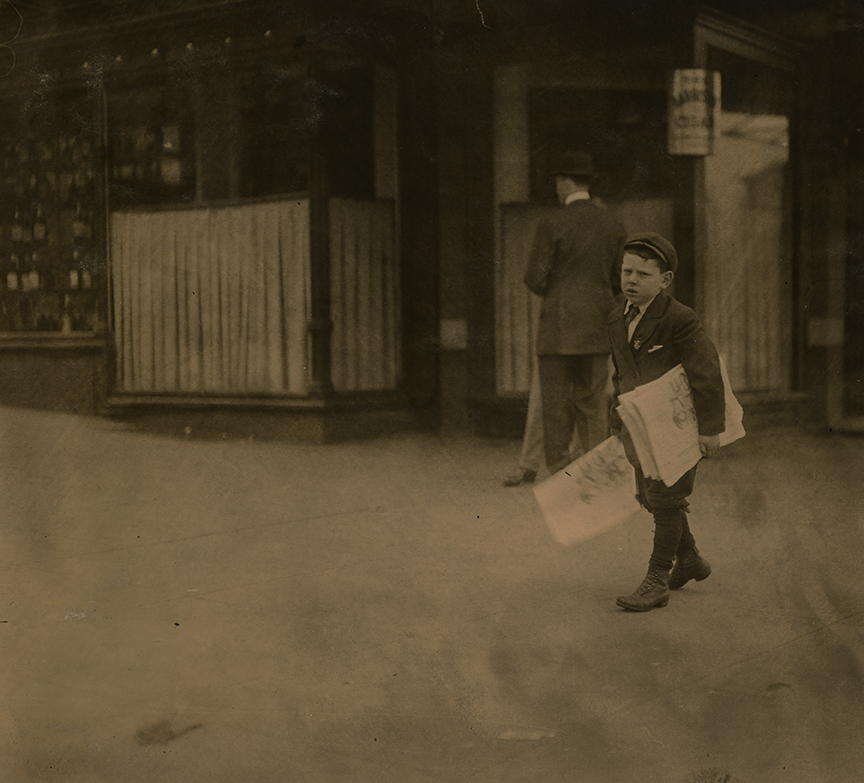
Lewis Hine, Israel April, 314 I St., S.W., Washington, D.C. "I serves the President." 9 yr. old newsboy with no badge selling near Willard Hotel, Sunday P.M., 4/14/12. Been selling for several years. I found him selling after midnight April 17th and 18th. Quite a pugnacious little chap. He and his brother are said to have a large clientele among ambassadors and senators. Location: Washington (D.C.), District of Columbia., 1912, Samuel Dorsky Museum of Art, gift of Howard Greenberg
In these images we see children and families struggling to break cycles of poverty, many of whom were recent immigrants, working together to survive. Although Hine’s unflinching photographs capture desperate situations, he recorded people’s images and listened to their stories with respect and compassion. Lewis Hine, Child Labor Investigator, shares a collection of photographs recently generously donated to the Dorsky Museum by Howard Greenberg.
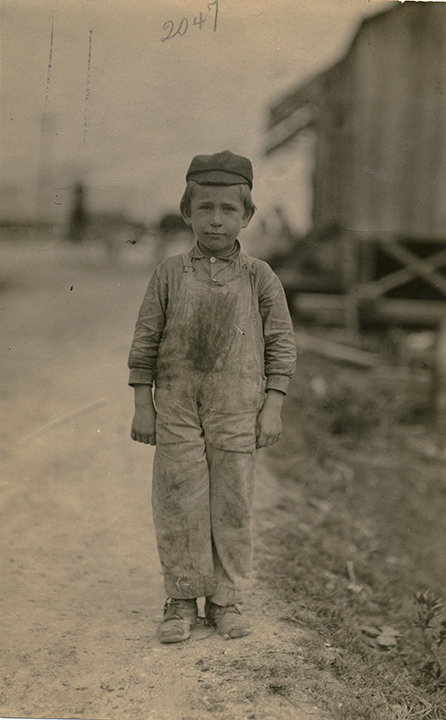
Lewis Hine, Joseph Velcich[?], seven years old. Beginning to pick shrimp for Peerless Oyster Co. Location: Bay St. Louis, Mississippi., 1911, Samuel Dorsky Museum of Art, gift of Howard Greenberg
Lewis Hine, Child Labor Investigator
Curated by Anna Conlan and Amy Fredrickson
February 6 – July 11, 2021
Sara Bedrick Gallery

Lewis Hine, Sadie Kelly, 11 years old, Picks shrimp for the Peerless Oyster Co. Picked 7 pots yesterday, 5 pots today at 5 cents. Picked last year., 1911, Samuel Dorsky Museum of Art, gift of Howard Greenberg
• See the Curator Talk with Amy Fredrickson on Lewis Hine, Child Labor Investigator
In 1908, Lewis Hine (1874–1940) quit his job as a New York City school teacher and embarked on a mission for the National Child Labor Committee to photograph young children working in unsafe conditions. For the next sixteen years, Hine traveled throughout the United States documenting the harsh lives of children—sometimes as young as four years old—who were working long days in factories, mills, farms, and coal mines. At this time there were no federal laws against child labor, and state regulations were routinely broken.

Lewis Hine, Powder puffs, 45 cents per gross. Family attempting to finish 9 gross in less than a week. Boy's hands were very dirty. Location: New Jersey., 1922, Samuel Dorsky Museum of Art, gift of Howard Greenberg
Hine understood the power of his photographs and their potential impact, and so did factory foremen. After his early photographs were published, implicated business owners claimed that Hine faked the images and stopped him from entering their factories and farms. Undeterred, Hine went undercover, sometimes posing as a Bible salesman or an insurance agent, and often waited outside factory gates for meal breaks or shift changes in order to photograph and interview the child-workers.
Hine captured thousands of photographs, conducted interviews, and made field notes that ultimately helped persuade the public and convince lawmakers to introduce new regulations to protect children.

Lewis Hine, Israel April, 314 I St., S.W., Washington, D.C. "I serves the President." 9 yr. old newsboy with no badge selling near Willard Hotel, Sunday P.M., 4/14/12. Been selling for several years. I found him selling after midnight April 17th and 18th. Quite a pugnacious little chap. He and his brother are said to have a large clientele among ambassadors and senators. Location: Washington (D.C.), District of Columbia., 1912, Samuel Dorsky Museum of Art, gift of Howard Greenberg
In these images we see children and families struggling to break cycles of poverty, many of whom were recent immigrants, working together to survive. Although Hine’s unflinching photographs capture desperate situations, he recorded people’s images and listened to their stories with respect and compassion. Lewis Hine, Child Labor Investigator, shares a collection of photographs recently generously donated to the Dorsky Museum by Howard Greenberg.

Lewis Hine, Joseph Velcich[?], seven years old. Beginning to pick shrimp for Peerless Oyster Co. Location: Bay St. Louis, Mississippi., 1911, Samuel Dorsky Museum of Art, gift of Howard Greenberg
SUNY New Paltz 1 Hawk Drive, New Paltz, NY 12561
845.257.3844
For more information contact us at [email protected]
